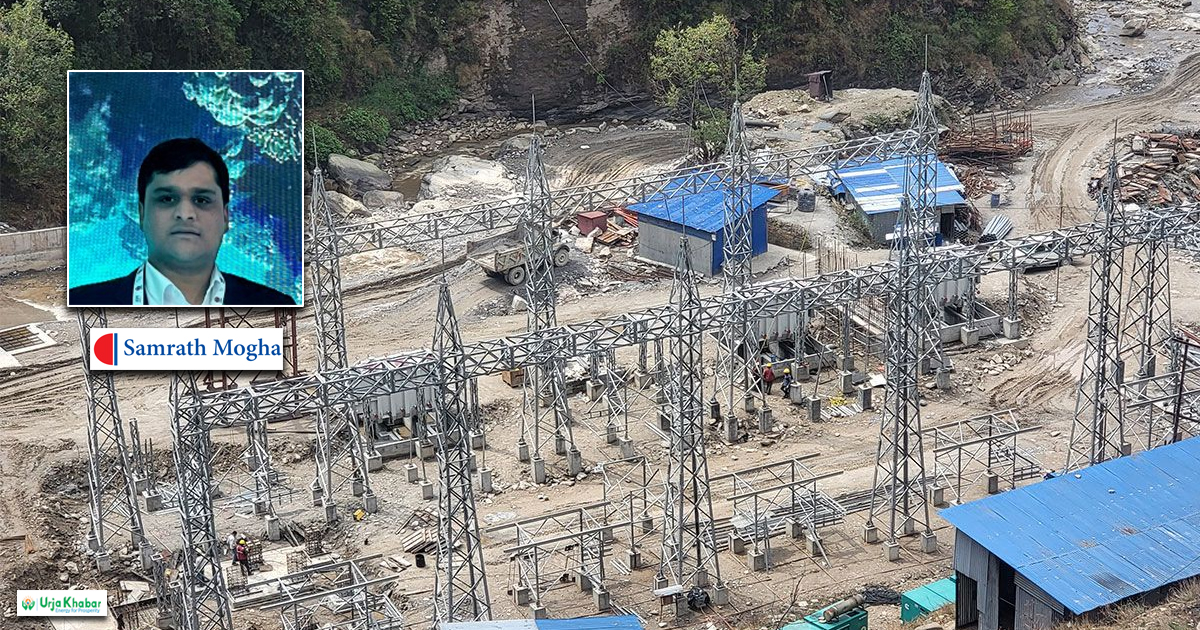
Many people have a reason to be fascinated with Nepal, some due to Mount Everest, some due to the beautiful valleys and the flowing rivers, and some due to the greenery. I am enchanted by its heritage. I was born to an Indian American father and a Nepali mother about some 30 years ago. I have been observing Nepal since my childhood and seeing the gap in development, the gap in the standard of living coming here for a month out of the 12 in a year. So, when I was 16, I found out about the possibilities in the energy sector in Nepal. I mean, I know this seems like a very young age, but this is true. I found out about the possibilities in the energy sector, and I went to college determined to become an engineer in the renewable space because I could see myself coming back here and hopefully generating a few megawatts of electricity and that’s what has happened.
In 2016, I established Mogha Energy, right after graduating, when I was 22. I came to Nepal to understand what the market was like and what the investments here were like. Through our local partners, MV Dugar Group, we decided in 2018 to invest in the Likhu-1, Likhu-2 and Likhu-A hydroelectric projects. We have come a long way since then, from a one-day drive and a two-day trek to reach our site. We can do it into our power plant.

Not only this, but we have also used the most advanced method of construction. Whether or not it is using the most, reliable tunneling equipment or the highest safety standards, we are the most experienced contractors and this has allowed us to set many records, one of which is the fastest tunnel construction in a month. We have done this with our formidable and skilled team in the country, and all of this has resulted in production of very highly reliable power plants at a good cost, generating more than 98 percent of the planned energy.
Now we are not only providing clean and green energy to the Nepalese grid, but we also believe that the hydropower story goes much further than that. If you look at the impact our projects have had, we’ve constructed 110 km of road while constructing the projects. I’ve not only gotten probably a little heavier, but this has impacted. This means that the people, roughly 40,000 to 50,000, who live alongside that road can now reach Kathmandu in about eight hours, as opposed to three days earlier. This means that doctors and teachers, who were not ready to walk three days to work somewhere, are now looking for opportunities in that area. This means that when a project is constructed, a hospital is built which is not only available to our local manpower but also to the local community.

Not only do roads help in an emergency but also directly affects the cost of living. Before this, a person would have to walk for two days to get a bag of rice, whereas it’s now available at their local shop. Furthermore, due to the construction of the projects, a local transmission line and a local grid are built much before the projects are commissioned. This brings light to every single household, much before the light from our powerhouses is produced. In addition, the provision of having 10 percent local people, which means 10 percent of our shares at the time of IPO, will be held by the local communities, which means that the local population is also participating in the wealth creation in which we are also gaining. That means every single local person in that area is also gaining directly and economically in their bank account.
When these projects are built, they have provided indirect and direct employment for nearly 5,000 people. Some of these people have been working in the GCC countries for five, ten and even 15 years with no hope of moving back and have seen their home maybe after a decade having, equivalent salaries, considering inflation higher than what they were receiving outside the country. Some of these people have worked for the first time on a project, developing skills that will then be used and transferred to other projects in the country as well.
Finally, every single hydropower project comes with CSR activities. As per the current government mandate, 0.75 percent of the cost of any project should be used for CSR related activities. What this means, if we look at the broader scheme of things, is that to develop 10,000 MW over the next 7 to 8 years, which is as per the government’s plan, we need to have mechanisms, that will induce a spending of almost $150 million on community support programs, and indirectly, 5 to 10 percent of every project’s cost is infrastructure development. So that’s one and a half to $2 billion in infrastructure development, which is the type of impact for which grant aid money is required, which can happen through the private sector, just through investment.
There are always some challenges we have to come across when developing any type of project in the Hindu Kush, whether that is, geological, whether that be technical, or whether that be social. But the government has always stood with us in helping us overcome these issues, the result of which is these commissioned assets. Without the government’s support, without the local government’s support, and without the local people’s support, it is impossible to do these projects. So, I think by executing these projects, you can understand what type of investment climate Nepal actually has to offer the world now.
Of course, we are very optimistic. I would go on to say we are very bullish about Nepal with the continued support of the government and our neighbors and our energy uptake. Nothing can stop Nepal from becoming the green battery of Southeast Asia. Not only does Nepal have the ability to generate electricity, which is important, but it also can store electricity because of its varied topography. This could allow a green stabilizing force to the grids of our neighbors.
And lastly, I would like to mention that with these assets now commissioned, Mogha Energy is putting our money where our mouth is. We are launching an infrastructure fund with the name of Mogha Infra Blocks Fund, and we are investing an additional $100 million over the next three years into the renewable energy sector in Nepal. In addition to this, Mogha Energy has a tie-up with Tata Power through an FDI investment in Dugar Power, and we are looking forward to developing 100 MW of rooftop solar over the next five years so that everybody in the country, not just people next to the grid, will have access to clean energy. Besides, we are also looking at utilizing solar power to address the country’s peak and off-peak load issues so that even in the winter, import requirements can be reduced from their current level.
To articulate simply, our plan is very ambitious. We hope to produce 1,000 MW in the next five years. It’s taken us about eight years to get to 161 MW, but I think it’s something that we can definitely achieve. And finally, we are also looking to bring this energy to every last in the country. For that, we are working with static to see how we could develop an EV charging network in the country. So, these are only to demonstrate that if we can do it as our friend from Unilever said, you can too.
I would like to end with an anecdote. Why do we do this at Mogha? A friend of mine asked me a year ago when we were in Pokhara. You know you’re going to end up commissioning your last project. Why are you doing this? What’s the purpose? What’s the end goal? And I thought about it for about a second, and I said, I wish I see the mountains every day from Kathmandu. I used to come here when I was young. And every single time, even in the monsoon, we would get to see the mountains every single day. But with global warming, with the climate where it currently stands, that’s not the case. So, for us, our goal is very simple. We are investing in Nepal so that our children and my grandchildren, can see the mountains every day. And we urge you to invest in Nepal so that your grandchildren can do the same.
Mogha is a New York-based visionary engineer known for his impactful investments in green energy, he is the president of Mogha Energy as well. With a decade-long experience, he has spearheaded projects like Likhu-1, Likhu-2, and Likhu-A, adding 161 MW to Nepal’s grid connection. His views are derived from his speech at the Nepal Investment Summit 2024, held in Kathmandu, Nepal, on April 28 and 29, 2024. This article is taken from the 6th issue of urja khabar, a bi-annual magazine. Which was published on 15 june, 2024.
